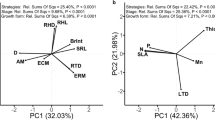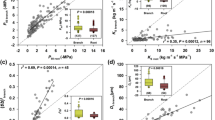Abstract
The study of functional traits and physiological mechanisms determining species’ drought tolerance is important for the prediction of their responses to climatic change. Fog-dependent forest patches in semiarid regions are a good study system with which to gain an understanding of species’ responses to increasing aridity and patch fragmentation. Here we measured leaf and hydraulic traits for three dominant species with contrasting distributions within patches in relict, fog-dependent forests in semiarid Chile. In addition, we assessed pressure–volume curve parameters in trees growing at a dry leeward edge and wet patch core. We predicted species would display contrasting suites of traits according to local water availability: from one end favoring water conservation and reducing cavitation risk, and from the opposite end favoring photosynthetic and hydraulic efficiency. Consistent with our hypothesis, we identified a continuum of water use strategies explaining species distribution along a small-scale moisture gradient. Drimys winteri, a tree restricted to the humid core, showed traits allowing efficient water transport and high carbon gain; in contrast, Myrceugenia correifolia, a tree that occurs in the drier patch edges, exhibited traits promoting water conservation and lower gas exchange rates, as well low water potential at turgor loss point. The most widespread species, Aextoxicon punctatum, showed intermediate trait values. Osmotic compensatory mechanism was detected in M. correifolia, but not in A. punctatum. We show that partitioning of the pronounced soil moisture gradients from patch cores to leeward edges among tree species is driven by differential drought tolerance. Such differences indicate that trees have contrasting abilities to cope with future reductions in soil moisture.



Similar content being viewed by others
References
Baltzer JL, Davies SJ, Bunyavejchewin S, Noor NSM (2008) The role of desiccation tolerance in determining tree species distributions along the Malay–Thai Peninsula. Funct Ecol 22:221–231. doi:10.1111/j.1365-2435.2007.01374.x
Barbosa O, Marquet PA, Bacigalupe LD, Christie DA, del-Val E, Gutiérrez AG, Jones CG, Weathers KC, Armesto JJ (2010) Interactions among patch area, forest structure and water fluxes in a fog-inundated forest ecosystem in semi-arid Chile. Funct Ecol 24:909–917. doi:10.1111/j.1365-2435.2010.01697.x
Bartlett M, Scoffoni C, Sack L (2012) The determinants of leaf turgor loss point and prediction of drought tolerance of species and biomes: a global meta-analysis. Ecol Lett 15:393–405. doi:10.1111/j.1461-0248.2012.01751.x
Bongers F, Poorter L, Van Rompaey RSAR, Parren MPE (1999) Distribution of twelve moist forest canopy tree species in Liberia and Cote d’Ivoire: response curves to a climatic gradient. J Veg Sci 10:371–382. doi:10.2307/3237066
Brodribb TJ, Feild TS (2000) Stem hydraulic supply is linked to leaf photosynthetic capacity: evidence from New Caledonian and Tasmanian rainforests. Plant Cell Environ 23:1381–1388. doi:10.1046/j.1365-3040.2000.00647.x
Cabrera HM (2002) Ecophysiological responses of plants in ecosystems with Mediterranean-like climate and high mountain environments. Rev Chil Hist Nat 75:625–637
Cereceda P, Osses P, Larraín H, Farías M, Lagos M, Pinto R, Schemenauer RS (2002) Advective, orographic and radiation fog in the Tarapacá region, Chile. Atmos Res 64:261–271
Choat B, Marilyn CB, Luly JG, Holtum JAM (2005) Hydraulic architecture of deciduous and evergreen dry rainforest tree species from north-eastern Australia. Trees Struct Funct 19:305–311. doi:10.1007/s00468-004-0392-1
Condit R (1998) Ecological implications of changes in drought patterns: shift in forest composition in Panama. Clim Change 39:413–427. doi:10.1023/A:1005395806800
Condit R, Pitman N, Leigh EG Jr, Chave J, Terborgh J, Foster RB, Nuñez-V P, Aguilar S, Valencia R, Villa G, Muller-Landau HC, Losos E, Hubbell SP (2002) Beta-diversity in tropical forest trees. Science 295:666–669. doi:10.1126/science.1066854
Cornelissen JHC, Lavorel S, Garnier E, Díaz S, Buchmann N, Gurvich DE, Reich PB, ter Steege H, Morgan HD, van der Heijden MGA, Pausas JG, Poorter H (2003) A handbook of protocols for standardised and easy measurement of plant functional traits worldwide. Aust J Bot 51:335–380. doi:10.1071/BT02124
Dawson TE (1998) Fog in the California redwood forest: ecosystem inputs and use by plants. Oecologia 117:476–485. doi:10.1007/s004420050683
del-Val E, Armesto JJ, Barbosa O, Christie DA, Gutiérrez AG, Jones CG, Marquet PA, Weathers KC (2006) Rain forest islands in the Chilean semiarid region: fog-dependency, ecosystem persistence and tree regeneration. Ecosystems 9:598–608. doi:10.1007/s10021-006-0065-6
Di Castri F, Hajek E (1976) Bioclimatología de Chile. Universidad Católica de Chile, Santiago
Di Rienzo JA, Casanoves F, Balzarini MG, Gonzalez L, Tablada M, Robledo CW (2011) InfoStat versión 2011. Grupo InfoStat, FCA, Universidad Nacional de Córdoba, Argentina. http://www.infostat.com.ar
Engelbrecht BMJ, Comita LS, Condit R, Kursar TA, Tyree MT, Turner BL, Hubbell SP (2007) Drought sensitivity shapes species distribution patterns in tropical forests. Nature 447:80–83. doi:10.1038/nature05747
Ewers FW, Fisher JB (1989) Techniques for measuring vessel lengths and diameters in 17 stems of woody plants. Am J Bot 76:645–656
Ewing HA, Weathers KC, Templer PH, Dawson TE, Firestone MK, Elliott AM, Boukili VKS (2009) Fog water and ecosystem function: heterogeneity in a California redwood forest. Ecosystems 12:417–433. doi:10.1007/s10021-009-9232-x
Feild TS, Holbrook NM (2000) Xylem sap flow and stem hydraulics of the vesselless angiosperm Drimys granadensis (Winteraceae) in a Costa Rican elfin forest. Plant Cell Environ 23:1067–1077. doi:10.1046/j.1365-3040.2000.00626.x
Feild TS, Zwieniecki MA, Donoghue MJ, Holbrook NM (1998) Stomatal plugs of Drimys winteri (Winteraceae) project leaves from mist but not drought. Proc Natl Acad Sci USA 95:14256–14259. doi:10.1073/pnas.95.24.14256
Figueroa JA, Cabrera HM, Queirolo C, Hinojosa LF (2010) Variability of water relations and photosynthesis in Eucryphia cordifolia Cav. (Cunoniaceae) over the range of its latitudinal and altitudinal distribution in Chile. Tree Physiol 30:574–585. doi:10.1093/treephys/tpq016
Gentry AH (1988) Changes in plant community diversity and floristic composition on environmental and geographic gradients. Ann Mo Bot Gard 75:1–34
Gutiérrez AG, Barbosa O, Christie DA, del-Val E, Ewing HA, Jones CG, Marquet PA, Weathers KC, Armesto JJ (2008) Regeneration patterns and persistence of the fog dependent Fray Jorge forest in semiarid Chile during the past two centuries. Glob Change Biol 14:161–176. doi:10.1111/j.1365-2486.2007.01482.x
Hacke UG, Sperry JS, Pockman WT, Davis SD, McCulloh K (2001) Trends in wood density and structure are linked to prevention of xylem implosion by negative pressure. Oecologia 126:457–461. doi:10.1007/s004420100628
Hacke UG, Sperry JS, Wheeler JK, Castro L (2006) Scaling of angiosperm xylem structure with safety and efficiency. Tree Physiol 26:689–701. doi:10.1093/treephys/26.6.689
Hacke UG, Sperry JS, Feild TS, Sano Y, Sikkema EH, Pittermann J (2007) Water transport in vesselless angiosperms: conducting efficiency and cavitation safety. Int J Plant Sci 168:1113–1126. doi:10.1086/520724
Hedin LO, Armesto JJ, Johnson AH (1995) Patterns of nutrient loss from unpolluted, old-growth temperate forests: evaluation of biogeochemical theory. Ecology 76:493–509
Hildebrandt A, Eltahir EAB (2006) Forest on the edge: seasonal cloud forest in Oman creates its own ecological niche. Geophys Res Lett 33:L11401. doi:10.1029/2006GL026022
Johnstone JA, Dawson TE (2010) Climatic context and ecological implications of summer fog decline in the coast redwood region. Proc Natl Acad Sci USA 107:4533–4538. doi:10.1073/pnas.0915062107
Katata G, Nagai H, Kajino M, Ueda H, Hozumi Y (2010) Numerical study of fog deposition on vegetation for atmosphere–land interactions in semi-arid and arid regions. Agric For Meteorol 150:340–353
Kozlowski TT, Pallardy SG (2002) Acclimation and adaptive responses of woody plants to environmental stresses. Bot Rev 68:270–334. doi:10.1663/0006-8101
Kursar TA, Engelbrecht BMJ, Burke A, Tyree MT, Omari BE, Giraldo JP (2009) Tolerance to low leaf water status of tropical tree seedlings is related to drought performance and distribution. Funct Ecol 23:93–102. doi:10.1111/j.1365-2435.2008.01483.x
López-Cortés F, López D (2004) Antecedentes bioclimáticos del Parque Nacional Bosque Fray Jorge. In: Squeo FA, Gutiérrez JR, Hernández IR (eds) Historia natural del parque nacional bosque Fray Jorge. Ediciones Universidad de La Serena, Chile, pp 45–60
Markesteijn L, Poorter L, Bongers F, Paz H, Sack L (2011a) Hydraulics and life history of tropical dry forest tree species: coordination of species’ drought and shade tolerance. New Phytol 191:480–495. doi:10.1111/j.1469-8137.2011.03708.x
Markesteijn L, Poorter L, Paz H, Sack L, Bongers F (2011b) Ecological differentiation in xylem cavitation resistance is associated with stem and leaf structural traits. Plant Cell Environ 34:137–148. doi:10.1111/j.1365-3040.2010.02231.x
Meinzer FC, Goldstein G, Jackson P, Holbrook NM, Gutiérrez MV, Cavelier J (1995) Environmental and physiological regulation of transpiration in tropical forest gap species: the influence of boundary layer and hydraulic properties. Oecologia 101:514–522. doi:10.1007/BF00329432
Mitchell PJ, Veneklaas EJ, Lambers H, Burguess SSO (2008) Using multiple trait associations to define hydraulic functional types in plant communities of south-western Australia. Oecologia 158:385–397. doi:10.1007/s00442-008-1152-5
Pérez C, Villagrán C (1985) Distribution of species abundances in relict forests of the Mediterranean zone of Chile. Rev Chil Hist Nat 58:157–170
Ponette-González A, Weathers KC, Curran LM (2009) Water inputs across a tropical montane landscape in Veracruz, Mexico: synergistic effects of land cover, rain and fog seasonality, and interannual precipitation variability. Glob Change Biol 16:46–49. doi:10.1111/j.1365-2486.2009.01985.x
Poorter L (2007) Are species adapted to their regeneration niche, adult niche, or both? Am Nat 169:433–442
Pyke CR, Condit R, Aguilar S, Lao S (2001) Floristic composition across a climatic gradient in a neotropical lowland forest. J Veg Sci 12:553–566. doi:10.2307/3237007
Sala OE, Chapin FS III, Armesto JJ, Berlow E, Bloomfield J, Dirzo R, Huber-Sanwald E, Huenneke LF, Jackson RB, Kinzig A, Leemans R, Lodge DM, Mooney HA, Oesterheld M, Poff NL, Sykes MT, Walker BH, Walker M, Wall DH (2000) Global biodiversity scenarios for the year 2100. Science 287:1770–1774. doi:10.1126/science.287.5459.1770
Santiago LS, Goldstein G, Meinzer FC, Fisher JB, Machado K, Woodruff D, Jones T (2004) Leaf photosynthetic traits scale with hydraulic conductivity and wood density in Panamanian forest canopy trees. Oecologia 140:543–550. doi:10.1007/s00442-004-1624-1
Sperry JS (2000) Hydraulic constraints on plant gas exchange. Agric For Meteorol 104:13–23
Sperry JS, Holbrook MN, Zimmermann M, Tyree MT (1987) Spring filling of xylem vessels in wild grapevine. Plant Physiol 83:414–417
Sperry JS, Donnelly JR, Tyree MT (1988) A method for measuring hydraulic conductivity and embolism in xylem. Plant Cell Environ 11:35–40. doi:10.1111/j.1365-3040.1988.tb01774.x
Sperry JS, Hacke UG, Feild TS, Sano Y, Sikkema EH (2007) Hydraulic consequences of vessel evolution in angiosperms. Int J Plant Sci 168:1127–1139. doi:10.1086/520726
Sterck F, Markesteijn L, Schieving F, Poorter L (2011) Functional traits determine trade-offs and niches in a tropical forest community. Proc Natl Acad Sci USA 108:20627–20632. doi:10.1073/pnas.1106950108
Villagrán C, Armesto JJ, Hinojosa LF, Cuvertino J, Pérez C, Medina C (2004) El enigmático origen del bosque relicto de Fray Jorge. In: Squeo FA, Gutiérrez JR, Hernández IR (eds) Historia natural del parque nacional bosque Fray Jorge. Ediciones Universidad de La Serena, Chile, pp 3–43
Weathers KC, Lovett GM, Likens GE, Caraco NFM (2000) Cloudwater inputs of nitrogen to forest ecosystems in southern Chile: forms, fluxes and sources. Ecosystems 3:590–595. doi:10.1007/s100210000051
Wright SJ (1992) Seasonal drought, soil fertility and the species density of tropical forest plant communities. Trends Ecol Evol 7:260–263
Acknowledgments
We would like to express our gratitude to Leonardo Ramirez, Felipe Albornoz, Rafaella Canessa, Aurora Gaxiola, Paulina Lobos, Juan Monardez, Carmen Ossa, Daniel Salinas, Daniel Stanton and Patricio Valenzuela for their invaluable assistance in the field and useful discussions and comments on the manuscript. This work was supported by CONICYT fellowship 24110074 to B. S.-N., and grants Fondecyt 1110929 to F. P., P05-002 from Millennium Scientific Initiative and PFB-23 from CONICYT to the Institute of Ecology and Biodiversity, Chile. This study is a contribution to LINC-Global (Chile-Spain) and to the Research Program of the Chilean Long-Term Socio-Ecological Research network at Fray Jorge National Park.
Author information
Authors and Affiliations
Corresponding author
Additional information
Communicated by Gerardo Avalos.
Rights and permissions
About this article
Cite this article
Negret, B.S., Pérez, F., Markesteijn, L. et al. Diverging drought-tolerance strategies explain tree species distribution along a fog-dependent moisture gradient in a temperate rain forest. Oecologia 173, 625–635 (2013). https://doi.org/10.1007/s00442-013-2650-7
Received:
Accepted:
Published:
Issue Date:
DOI: https://doi.org/10.1007/s00442-013-2650-7




